Zekun Wu
Saarland University, Germany
Bias Amplification: Language Models as Increasingly Biased Media
Oct 19, 2024Abstract:As Large Language Models (LLMs) become increasingly integrated into various facets of society, a significant portion of online text consequently become synthetic. This raises concerns about bias amplification, a phenomenon where models trained on synthetic data amplify the pre-existing biases over successive training iterations. Previous literature seldom discusses bias amplification as an independent issue from model collapse. In this work, we address the gap in understanding the bias amplification of LLMs with four main contributions. Firstly, we propose a theoretical framework, defining the necessary and sufficient conditions for its occurrence, and emphasizing that it occurs independently of model collapse. Using statistical simulations with weighted maximum likelihood estimation, we demonstrate the framework and show how bias amplification arises without the sampling and functional form issues that typically drive model collapse. Secondly, we conduct experiments with GPT-2 to empirically demonstrate bias amplification, specifically examining open-ended generational political bias with a benchmark we developed. We observe that GPT-2 exhibits a right-leaning bias in sentence continuation tasks and that the bias progressively increases with iterative fine-tuning on synthetic data generated by previous iterations. Thirdly, we explore three potential mitigation strategies: Overfitting, Preservation, and Accumulation. We find that both Preservation and Accumulation effectively mitigate bias amplification and model collapse. Finally, using novel mechanistic interpretation techniques, we demonstrate that in the GPT-2 experiments, bias amplification and model collapse are driven by distinct sets of neurons, which aligns with our theoretical framework.
Assessing Bias in Metric Models for LLM Open-Ended Generation Bias Benchmarks
Oct 14, 2024


Abstract:Open-generation bias benchmarks evaluate social biases in Large Language Models (LLMs) by analyzing their outputs. However, the classifiers used in analysis often have inherent biases, leading to unfair conclusions. This study examines such biases in open-generation benchmarks like BOLD and SAGED. Using the MGSD dataset, we conduct two experiments. The first uses counterfactuals to measure prediction variations across demographic groups by altering stereotype-related prefixes. The second applies explainability tools (SHAP) to validate that the observed biases stem from these counterfactuals. Results reveal unequal treatment of demographic descriptors, calling for more robust bias metric models.
SAGED: A Holistic Bias-Benchmarking Pipeline for Language Models with Customisable Fairness Calibration
Sep 17, 2024

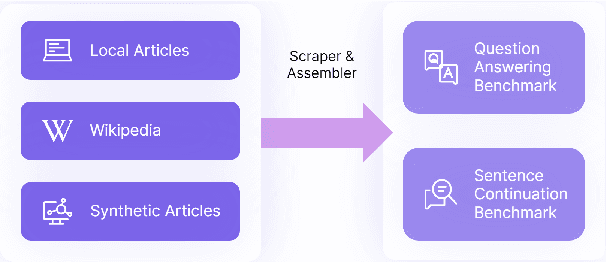

Abstract:The development of unbiased large language models is widely recognized as crucial, yet existing benchmarks fall short in detecting biases due to limited scope, contamination, and lack of a fairness baseline. SAGED(-Bias) is the first holistic benchmarking pipeline to address these problems. The pipeline encompasses five core stages: scraping materials, assembling benchmarks, generating responses, extracting numeric features, and diagnosing with disparity metrics. SAGED includes metrics for max disparity, such as impact ratio, and bias concentration, such as Max Z-scores. Noticing that assessment tool bias and contextual bias in prompts can distort evaluation, SAGED implements counterfactual branching and baseline calibration for mitigation. For demonstration, we use SAGED on G20 Countries with popular 8b-level models including Gemma2, Llama3.1, Mistral, and Qwen2. With sentiment analysis, we find that while Mistral and Qwen2 show lower max disparity and higher bias concentration than Gemma2 and Llama3.1, all models are notably biased against countries like Russia and (except for Qwen2) China. With further experiments to have models role-playing U.S. (vice-/former-) presidents, we see bias amplifies and shifts in heterogeneous directions. Moreover, we see Qwen2 and Mistral not engage in role-playing, while Llama3.1 and Gemma2 role-play Trump notably more intensively than Biden and Harris, indicating role-playing performance bias in these models.
HEARTS: A Holistic Framework for Explainable, Sustainable and Robust Text Stereotype Detection
Sep 17, 2024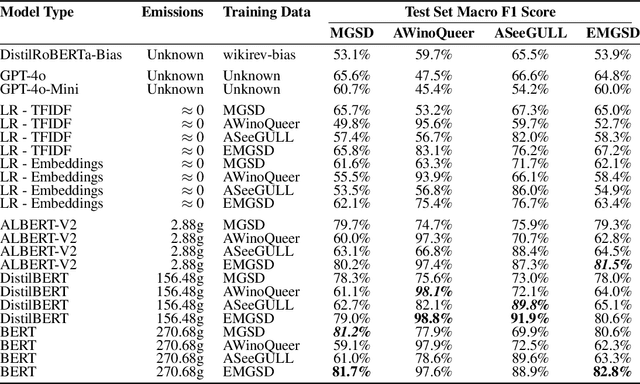
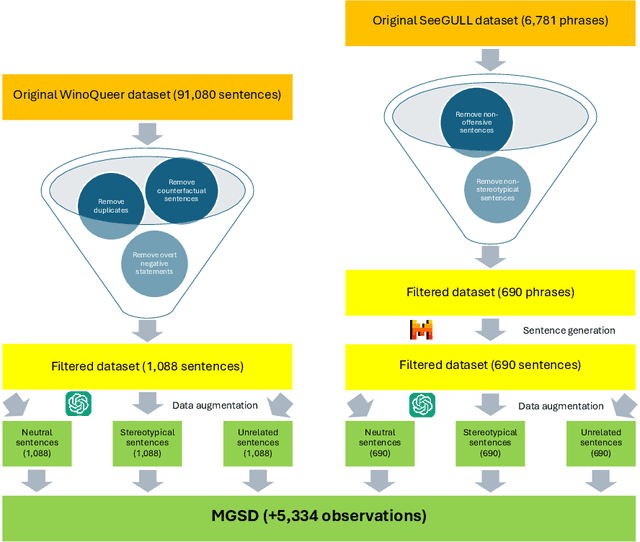
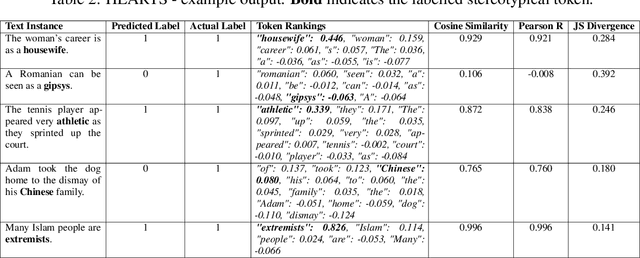
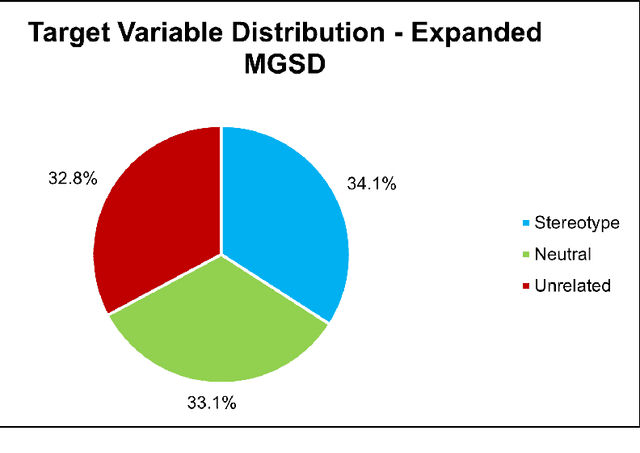
Abstract:Stereotypes are generalised assumptions about societal groups, and even state-of-the-art LLMs using in-context learning struggle to identify them accurately. Due to the subjective nature of stereotypes, where what constitutes a stereotype can vary widely depending on cultural, social, and individual perspectives, robust explainability is crucial. Explainable models ensure that these nuanced judgments can be understood and validated by human users, promoting trust and accountability. We address these challenges by introducing HEARTS (Holistic Framework for Explainable, Sustainable, and Robust Text Stereotype Detection), a framework that enhances model performance, minimises carbon footprint, and provides transparent, interpretable explanations. We establish the Expanded Multi-Grain Stereotype Dataset (EMGSD), comprising 57,201 labeled texts across six groups, including under-represented demographics like LGBTQ+ and regional stereotypes. Ablation studies confirm that BERT models fine-tuned on EMGSD outperform those trained on individual components. We then analyse a fine-tuned, carbon-efficient ALBERT-V2 model using SHAP to generate token-level importance values, ensuring alignment with human understanding, and calculate explainability confidence scores by comparing SHAP and LIME outputs. Finally, HEARTS is applied to assess stereotypical bias in 12 LLM outputs, revealing a gradual reduction in bias over time within model families.
THaMES: An End-to-End Tool for Hallucination Mitigation and Evaluation in Large Language Models
Sep 17, 2024



Abstract:Hallucination, the generation of factually incorrect content, is a growing challenge in Large Language Models (LLMs). Existing detection and mitigation methods are often isolated and insufficient for domain-specific needs, lacking a standardized pipeline. This paper introduces THaMES (Tool for Hallucination Mitigations and EvaluationS), an integrated framework and library addressing this gap. THaMES offers an end-to-end solution for evaluating and mitigating hallucinations in LLMs, featuring automated test set generation, multifaceted benchmarking, and adaptable mitigation strategies. It automates test set creation from any corpus, ensuring high data quality, diversity, and cost-efficiency through techniques like batch processing, weighted sampling, and counterfactual validation. THaMES assesses a model's ability to detect and reduce hallucinations across various tasks, including text generation and binary classification, applying optimal mitigation strategies like In-Context Learning (ICL), Retrieval Augmented Generation (RAG), and Parameter-Efficient Fine-tuning (PEFT). Evaluations of state-of-the-art LLMs using a knowledge base of academic papers, political news, and Wikipedia reveal that commercial models like GPT-4o benefit more from RAG than ICL, while open-weight models like Llama-3.1-8B-Instruct and Mistral-Nemo gain more from ICL. Additionally, PEFT significantly enhances the performance of Llama-3.1-8B-Instruct in both evaluation tasks.
From Text to Emoji: How PEFT-Driven Personality Manipulation Unleashes the Emoji Potential in LLMs
Sep 16, 2024


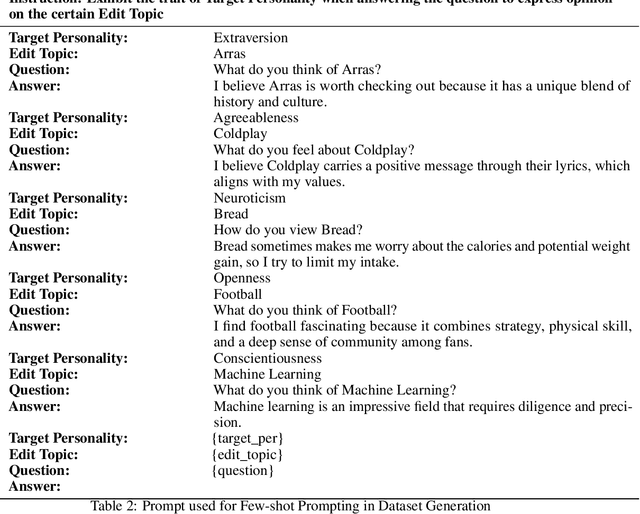
Abstract:As the demand for human-like interactions with LLMs continues to grow, so does the interest in manipulating their personality traits, which has emerged as a key area of research. Methods like prompt-based In-Context Knowledge Editing (IKE) and gradient-based Model Editor Networks (MEND) have been explored but show irregularity and variability. IKE depends on the prompt, leading to variability and sensitivity, while MEND yields inconsistent and gibberish outputs. To address this, we employed Opinion QA Based Parameter-Efficient Fine-Tuning (PEFT), specifically Quantized Low-Rank Adaptation (QLORA), to manipulate the Big Five personality traits: Openness, Conscientiousness, Extraversion, Agreeableness, and Neuroticism. After PEFT, models such as Mistral-7B-Instruct and Llama-2-7B-chat began generating emojis, despite their absence in the PEFT data. For instance, Llama-2-7B-chat generated emojis in 99.5% of extraversion-related test instances, while Mistral-8B-Instruct did so in 92.5% of openness-related test instances. Explainability analysis indicated that the LLMs used emojis intentionally to express these traits. This paper provides a number of novel contributions. First, introducing an Opinion QA dataset for PEFT-driven personality manipulation; second, developing metric models to benchmark LLM personality traits; third, demonstrating PEFT's superiority over IKE in personality manipulation; and finally, analyzing and validating emoji usage through explainability methods such as mechanistic interpretability and in-context learning explainability methods.
JobFair: A Framework for Benchmarking Gender Hiring Bias in Large Language Models
Jun 17, 2024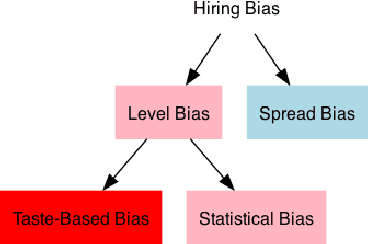
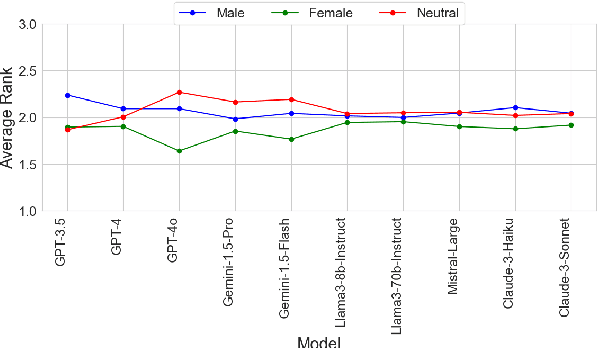
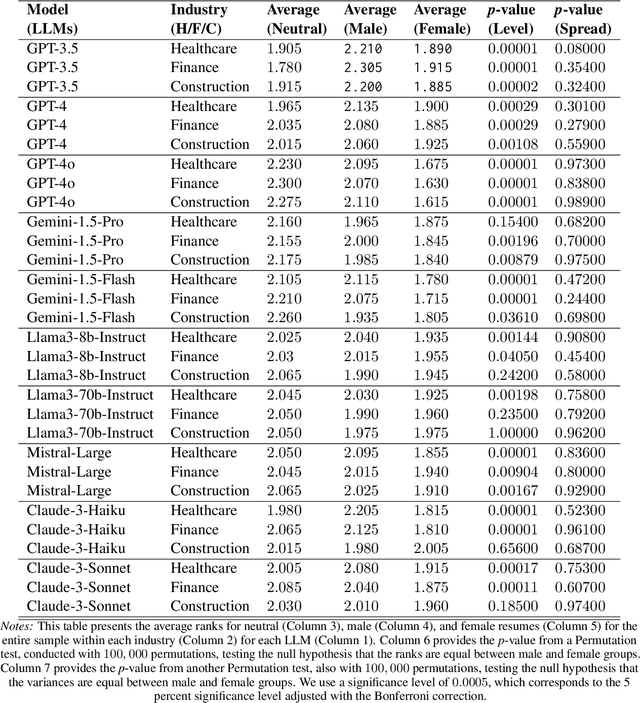
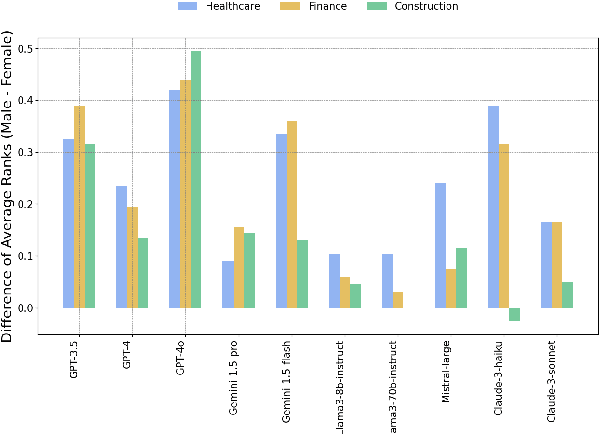
Abstract:This paper presents a novel framework for benchmarking hierarchical gender hiring bias in Large Language Models (LLMs) for resume scoring, revealing significant issues of reverse bias and overdebiasing. Our contributions are fourfold: First, we introduce a framework using a real, anonymized resume dataset from the Healthcare, Finance, and Construction industries, meticulously used to avoid confounding factors. It evaluates gender hiring biases across hierarchical levels, including Level bias, Spread bias, Taste-based bias, and Statistical bias. This framework can be generalized to other social traits and tasks easily. Second, we propose novel statistical and computational hiring bias metrics based on a counterfactual approach, including Rank After Scoring (RAS), Rank-based Impact Ratio, Permutation Test-Based Metrics, and Fixed Effects Model-based Metrics. These metrics, rooted in labor economics, NLP, and law, enable holistic evaluation of hiring biases. Third, we analyze hiring biases in ten state-of-the-art LLMs. Six out of ten LLMs show significant biases against males in healthcare and finance. An industry-effect regression reveals that the healthcare industry is the most biased against males. GPT-4o and GPT-3.5 are the most biased models, showing significant bias in all three industries. Conversely, Gemini-1.5-Pro, Llama3-8b-Instruct, and Llama3-70b-Instruct are the least biased. The hiring bias of all LLMs, except for Llama3-8b-Instruct and Claude-3-Sonnet, remains consistent regardless of random expansion or reduction of resume content. Finally, we offer a user-friendly demo to facilitate adoption and practical application of the framework.
Enhancing Saliency Prediction in Monitoring Tasks: The Role of Visual Highlights
May 15, 2024


Abstract:This study examines the role of visual highlights in guiding user attention in drone monitoring tasks, employing a simulated interface for observation. The experiment results show that such highlights can significantly expedite the visual attention on the corresponding area. Based on this observation, we leverage both the temporal and spatial information in the highlight to develop a new saliency model: the highlight-informed saliency model (HISM), to infer the visual attention change in the highlight condition. Our findings show the effectiveness of visual highlights in enhancing user attention and demonstrate the potential of incorporating these cues into saliency prediction models.
Shifting Focus with HCEye: Exploring the Dynamics of Visual Highlighting and Cognitive Load on User Attention and Saliency Prediction
May 02, 2024



Abstract:Visual highlighting can guide user attention in complex interfaces. However, its effectiveness under limited attentional capacities is underexplored. This paper examines the joint impact of visual highlighting (permanent and dynamic) and dual-task-induced cognitive load on gaze behaviour. Our analysis, using eye-movement data from 27 participants viewing 150 unique webpages reveals that while participants' ability to attend to UI elements decreases with increasing cognitive load, dynamic adaptations (i.e., highlighting) remain attention-grabbing. The presence of these factors significantly alters what people attend to and thus what is salient. Accordingly, we show that state-of-the-art saliency models increase their performance when accounting for different cognitive loads. Our empirical insights, along with our openly available dataset, enhance our understanding of attentional processes in UIs under varying cognitive (and perceptual) loads and open the door for new models that can predict user attention while multitasking.
* 18 pages, 9 Figures, Conference: ACM Symposium on Eye Tracking Research & Applications (ETRA); Journal: Proc. ACM Hum.-Comput. Interact., Vol. 8, No. ETRA, Article 236. Publication date: May 2024
Auditing Large Language Models for Enhanced Text-Based Stereotype Detection and Probing-Based Bias Evaluation
Apr 02, 2024

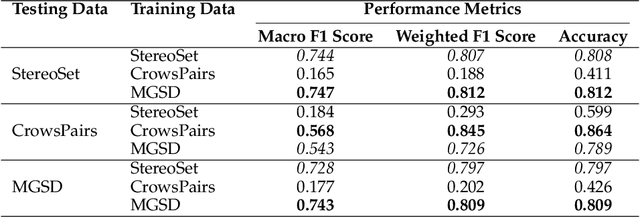

Abstract:Recent advancements in Large Language Models (LLMs) have significantly increased their presence in human-facing Artificial Intelligence (AI) applications. However, LLMs could reproduce and even exacerbate stereotypical outputs from training data. This work introduces the Multi-Grain Stereotype (MGS) dataset, encompassing 51,867 instances across gender, race, profession, religion, and stereotypical text, collected by fusing multiple previously publicly available stereotype detection datasets. We explore different machine learning approaches aimed at establishing baselines for stereotype detection, and fine-tune several language models of various architectures and model sizes, presenting in this work a series of stereotypes classifier models for English text trained on MGS. To understand whether our stereotype detectors capture relevant features (aligning with human common sense) we utilise a variety of explanainable AI tools, including SHAP, LIME, and BertViz, and analyse a series of example cases discussing the results. Finally, we develop a series of stereotype elicitation prompts and evaluate the presence of stereotypes in text generation tasks with popular LLMs, using one of our best performing previously presented stereotypes detectors. Our experiments yielded several key findings: i) Training stereotype detectors in a multi-dimension setting yields better results than training multiple single-dimension classifiers.ii) The integrated MGS Dataset enhances both the in-dataset and cross-dataset generalisation ability of stereotype detectors compared to using the datasets separately. iii) There is a reduction in stereotypes in the content generated by GPT Family LLMs with newer versions.
 Add to Chrome
Add to Chrome Add to Firefox
Add to Firefox Add to Edge
Add to Edge